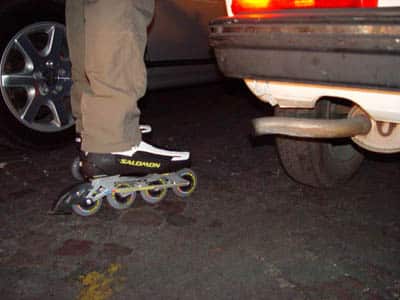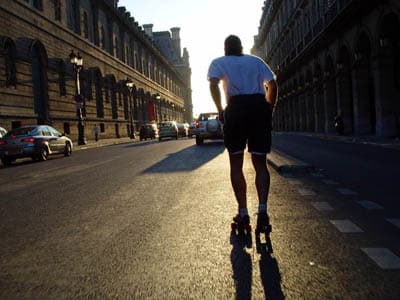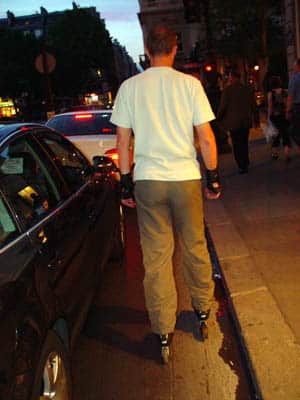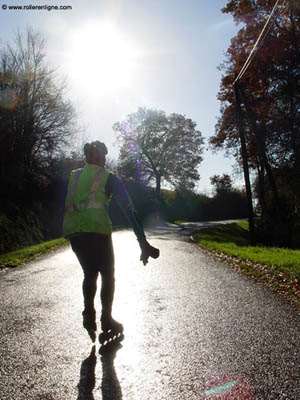Impact of pollution on skaters’ health
Like cyclists, runners and other urban sports people, skaters suffer from pollution and its impact on their bodies. Stéphane Dupas offers to estimate the impacts of physical activity in cities. Report…
Originally issued on January 2006, updated in 2008
Skating and pollution
 Skating as seen today spread around the world in the early 90’s, and in France from 1995 on. It witnessed a phenomenal boom in Paris thanks to the strikes of the Fall of 1996. Since then, it proved to be an efficient means of transport in cities, making light of transport strikes and traffic jams. In Paris, skating became a means of transport with lots of advantages:
Skating as seen today spread around the world in the early 90’s, and in France from 1995 on. It witnessed a phenomenal boom in Paris thanks to the strikes of the Fall of 1996. Since then, it proved to be an efficient means of transport in cities, making light of transport strikes and traffic jams. In Paris, skating became a means of transport with lots of advantages:
- often comparatively faster than cycling for the same route
- noiseless
- non-polluting
- not cumbersome when not used
- not very expansive
Even if a few brave skaters threw themselves into great journeys in the countryside (like the Parisian association ‘Planetroller’), skating remained confined to urban areas. Thousands of people can do sport, or at least ‘breathe’ thanks to skating…
Breathing?
We asked ourselves about the impact of atmospheric pollution on skating in big cities, especially in Paris. That analysis is not exhaustive but brings information on a question that is too often avoided. We are not doctors or epidemiologists. We have just gathered information from diverse sources in order to make a synthesis adapted to skating.
The chosen field of skating is the street (sidewalks, cycle lanes, streets), even if legally speaking, skaters should stay on the sidewalk. Just like cycling, skating needs important efforts, and all the more when you want to go fast.
That is why, whatever the sports level of the skater, he is exposed to some risks:
- there is a proportional increase of the quantity of inhaled pollutants with the increase of your breathing
- a bigger part of the inhaled air goes through the mouth during effort, avoiding the nasal passage, which is meant to filter big particles and soluble vapors
- the speed increase of the breathed air brings pollutants deeper into the respiratory system.
- moreover, it has been proved that the capacity of diffusion at the lungs in bigger during effort (Carlisle and Sharp, 2001).
 List of the main atmospheric pollutants in cities
List of the main atmospheric pollutants in cities
- carbon monoxide
- sulphur oxide
- nitrogen oxide
- light hydrocarbons
- volatile organic compounds
- suspended particles
- ozone
- etc.
Origin of these pollutants
- the sulphur oxide (SO2) comes from factory chimneys, heaters and diesel cars
- 40% of the suspended particles come from transports
- 60% of the nitrogen oxide (NOx) come from transports
- the ozone (O3) is obtained by chemical reaction between nitrogen oxide and hydrocarbon (car pollutants)
- 43% of the carbon monoxide (CO) also come from transport
- the volatile organic compounds are released during the evaporation of fuel (tank filling) or by exhaust gas.
Impact of those pollutants on skaters’ health
Carbon monoxide
That colorless and odorless gas sticks to haemoglobin instead of oxygen and thus reduces the oxygen intake of the tissues, and causes hypoxia.
Some studies showed that practicing sport during 30 min in dense traffic increases the blood rate by 10 (equals 10 cigarettes) compared to a walker.
Likewise, a rate of 4-6% of CO in the blood of urban joggers and cyclists is comparable to that of a chronic cigarette smoker. The CO in the blood disappears after 3 to 4 hours of breathing clear air (Carlisle and Sharp, 2001).
Nitrogen oxides (NO and NO2)
 The NO2 is the most toxic. Exposure to 5-10ppm doses causes respiratory diseases: pharynx irritation, cough, dyspnoea. Moreover, it causes a weakening to respiratory infections during exposures of less than 0.5ppm. The risks of respiratory infections increase by 20% for children with prolonged exposures to NO2 at 0.016ppm (Carlisle and Sharp, 2001; Pref Herault).
The NO2 is the most toxic. Exposure to 5-10ppm doses causes respiratory diseases: pharynx irritation, cough, dyspnoea. Moreover, it causes a weakening to respiratory infections during exposures of less than 0.5ppm. The risks of respiratory infections increase by 20% for children with prolonged exposures to NO2 at 0.016ppm (Carlisle and Sharp, 2001; Pref Herault).
Ozone
Exposure to ozone is known to have detrimental effects on health. Symptoms are eye, nose and throat irritations, as well as coughs. It is harmful to children and asthmatic people’s breathing apparatus. Nausea and headache may appear if exposure to ozone becomes more important (Carlisle and Sharp, 2001; Pref Herault).
Suspended particles
They are linked to the increase of cardio-vascular morbidity. The have an incidence on short-term mortality by respiratory or cardio-vascular affection, and on long-term mortality with their mutagenic and carcinogenic powers (Airparif). We also know that those particles penetrate further into the respiratory system during effort, but we do not know if effort increases their deposit (Carlisle and Sharp, 2001).
Sulphur oxides
The SO2 starts to have an effect on sane people’s bronchi from 1-2ppm, and as soon as 0.25ppm on asthmatic people (Carlisle and Sharp, 2001), causing coughs and breathlessness, and making asthma and chronic bronchitis worse (Pref Herault).
SO2 may have an impact on short-term mortality by respiratory or cardio-vascular affections (Airparif).
Volatile organic compounds
A lot of chemical compounds enter that category (Carlisle and Sharp, 2001). Some are known as mutagenic and carcinogenic, causing an impact on long-term mortality (Airparif).
Should you keep on skating?
These elements are not very encouraging, are they? Rest assured! Several arguments are positive:
- At the information and recommendation threshold, children (sensitive subjects) can go out and do moderate physical activities (Pref Herault)
- The alert thresholds due to a high concentration of those pollutants are not frequent. However, during pollution alerts, it is better not to overdo things. Besides, there are peak times for some pollutants, like for example from 12AM-2PM to 9PM for ozone (Pref Herault). Keep up to date!
- Some studies show that the concentration of lots of those pollutants is bigger in cars and buses than for cyclists doing the same route (Gee and Raper, 1999). Explanation: most of the time, cyclists are on the side of the road where the concentration of particles tends to be lower and most of the time too, they avoid traffic jams (Gee and Raper, 1999). These two arguments are even stronger for skaters who are meant to stay on the sidewalk.
You can also stretch your legs at one of those organized street skates during which the traffic is momentarily stopped (egg. Rollers & Coquillages or Pari Roller in Paris, Fra).
Otherwise, what to do?
 Forked tongues will simply say ‘stop skating’. Which would not be fair as skating suffers from pollution, it is not responsible for it.
Forked tongues will simply say ‘stop skating’. Which would not be fair as skating suffers from pollution, it is not responsible for it.
Banning cars?
No, cars are useful tools. However you can encourage initiatives to develop less polluting vehicles (Moteurnature).
Beltwaytopia?
Encouraging symbolical and surprising ideas: leaving the Parisian beltway to cyclists, skaters and runners for a race (Périféerique).
Writing a letter to your political leaders
You can write to mayors, prefects, deputies, to the minister for the environment (do not forget that you are the ones who elect them!) and ask them to act and enable skaters to practice their passion in good sanitary conditions.
Putting a filter mask on?
Here is an alternative solution. However, most of the masks are quite useless. A handkerchief may limit the absorption of particles but will not prevent gas from passing. Filter masks for gas are bulky (canister filter, covering of the face with hermetic seals).
They are rarely designed for a sports use (limited output of filtered air, steam on the mask). Moreover, try and go for a skate in the street with a mask on your face and you will be pointed out that you are late for Halloween.
Conclusion?
No alarmism! Skating is still good for health, even if practicing in cities may be risky, especially next to roads with heavy traffic and during pollution peaks. Off-peak periods and rural areas are better of course.
Key information
A couple of definitions
Recommendation threshold: concentration rate of polluting substances beyond which there are limited and transitory effects on the health of sensitive categories of population in case of short-term exposure (Air-LR).
Alert threshold: concentration rate of polluting substances in the atmosphere beyond which a short-term exposure represents a risk for human health and for which emergency measures should be taken (Air-LR).
Sources and references
- Carlisle A.J. et Sharp N.C.C. (2001) – Exercice and outdoor ambient air pollution. Br. J. Sports Med., 35 : 214-222
- Gee I.L. et Raper D.W. (1999) – Commuter exposure to respirable particles inside buses and by bicycles. The Science of the Total Environment, 235 : 403-405
Links
Benefits of roller-skating on health
Precautions to take while skating by cold weather
Strengthen your ankles for a better practice
To feel secure with roller skates under rain
Trekking: Safety instructions for open road skating
Translation: Chloé Seyres
Photos: Rollerenligne.com
